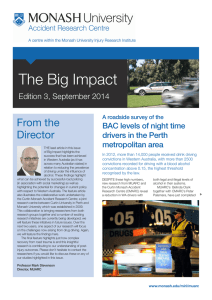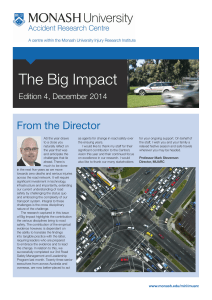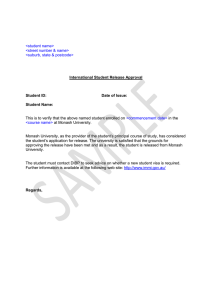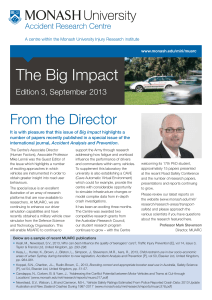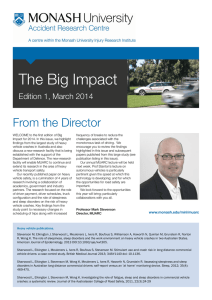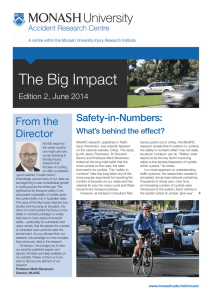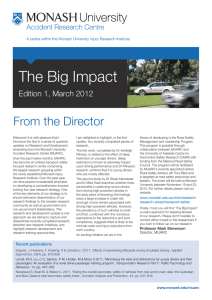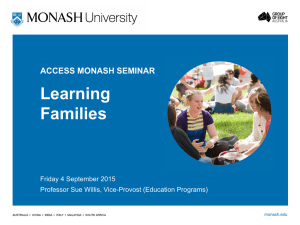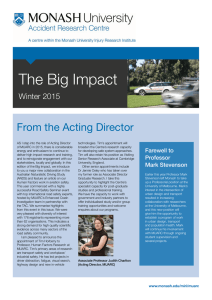The Big Impact From the Acting Director Summer 2015
advertisement
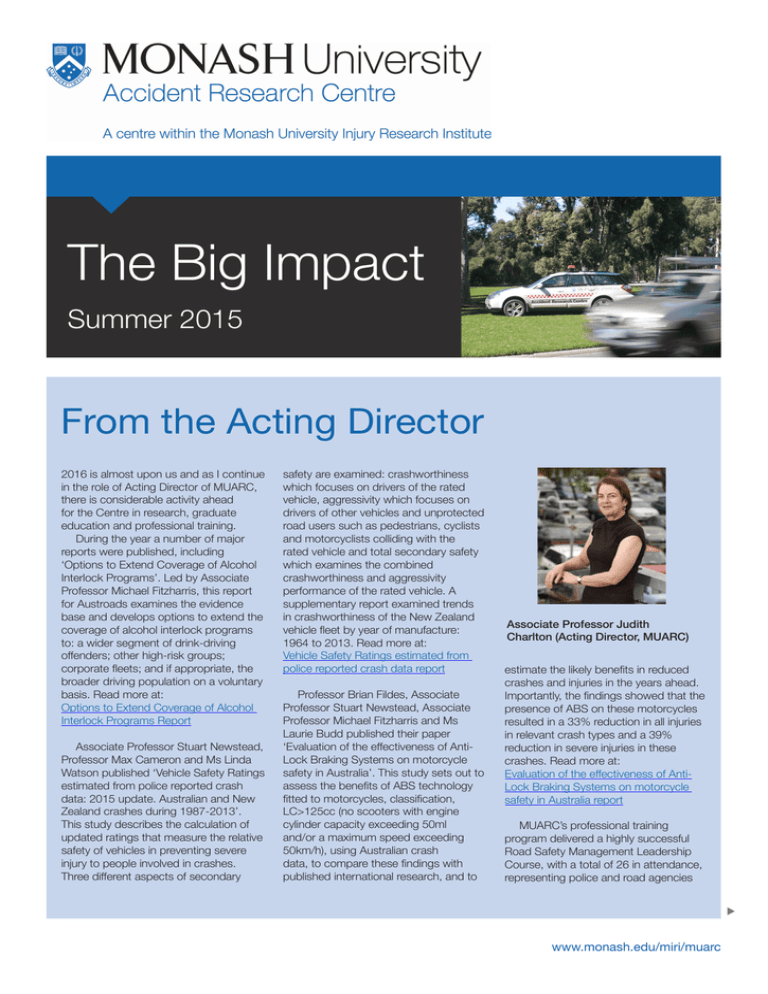
The Big Impact Summer 2015 From the Acting Director 2016 is almost upon us and as I continue in the role of Acting Director of MUARC, there is considerable activity ahead for the Centre in research, graduate education and professional training. During the year a number of major reports were published, including ‘Options to Extend Coverage of Alcohol Interlock Programs’. Led by Associate Professor Michael Fitzharris, this report for Austroads examines the evidence base and develops options to extend the coverage of alcohol interlock programs to: a wider segment of drink-driving offenders; other high-risk groups; corporate fleets; and if appropriate, the broader driving population on a voluntary basis. Read more at: Options to Extend Coverage of Alcohol Interlock Programs Report Associate Professor Stuart Newstead, Professor Max Cameron and Ms Linda Watson published ‘Vehicle Safety Ratings estimated from police reported crash data: 2015 update. Australian and New Zealand crashes during 1987-2013’. This study describes the calculation of updated ratings that measure the relative safety of vehicles in preventing severe injury to people involved in crashes. Three different aspects of secondary safety are examined: crashworthiness which focuses on drivers of the rated vehicle, aggressivity which focuses on drivers of other vehicles and unprotected road users such as pedestrians, cyclists and motorcyclists colliding with the rated vehicle and total secondary safety which examines the combined crashworthiness and aggressivity performance of the rated vehicle. A supplementary report examined trends in crashworthiness of the New Zealand vehicle fleet by year of manufacture: 1964 to 2013. Read more at: Vehicle Safety Ratings estimated from police reported crash data report Professor Brian Fildes, Associate Professor Stuart Newstead, Associate Professor Michael Fitzharris and Ms Laurie Budd published their paper ‘Evaluation of the effectiveness of AntiLock Braking Systems on motorcycle safety in Australia’. This study sets out to assess the benefits of ABS technology fitted to motorcycles, classification, LC>125cc (no scooters with engine cylinder capacity exceeding 50ml and/or a maximum speed exceeding 50km/h), using Australian crash data, to compare these findings with published international research, and to Associate Professor Judith Charlton (Acting Director, MUARC) estimate the likely benefits in reduced crashes and injuries in the years ahead. Importantly, the findings showed that the presence of ABS on these motorcycles resulted in a 33% reduction in all injuries in relevant crash types and a 39% reduction in severe injuries in these crashes. Read more at: Evaluation of the effectiveness of AntiLock Braking Systems on motorcycle safety in Australia report MUARC’s professional training program delivered a highly successful Road Safety Management Leadership Course, with a total of 26 in attendance, representing police and road agencies u www.monash.edu/miri/muarc from four countries; India, South Africa, New Zealand and Australia. In addition, MUARC delivered four road safety leadership programs for VicRoads in partnership with colleagues from CASR and the University of Melbourne. More on the Road Safety Management Leadership program for 2016 will be posted soon on the MUARC website. Our Graduate Education program continues to expand with students across the MPhil and PhD programs. In 2016, MUARC will host two students to undertake full-time PhD research at Monash University as part of a Graduate Research Interdisciplinary Program (GRIP). This GRIP brings together six faculties and focuses on the topic of Sustainable and Effective Public Transport (SEPT). The SEPT-GRIP is jointly funded by Monash University and industry groups, including Public Transport Victoria, Metro Trains Melbourne, Yarra Trams, VicRoads, Transdev Melbourne and the Bus Association of Victoria. The program includes an advanced, collaborative professional development program based in the field with industry. www.monash.edu/graduate-research/ partnerships/grips/sept Building international links Dr Sharon Newnam spent part of the year on a study program in the US. Sharon was based in the US at the University of Michigan Transportation Institute (UMTRI) from March to August. The purpose of the trip was to develop her program of research in workplace road safety, with a focus on building international collaborations. Key activities included writing grant applications, industry presentations (Michigan Truck Safety Centre, Fedex, National Safety Council) and conference presentations (National Institute for Occupational Safety and Health, Michigan Safety Conference). Sharon and colleagues successfully secured a grant from the Advancing Transportation and Leadership Safety (ATLAS) and a MIRI seeding grant to support new projects focusing on (i) automated vehicles in the workplace and (ii) safety intervention for older truck drivers. Sharon also presented her program of research at the Institute of Work and Health in Toronto, Canada and the Ministry of Transportation. In this issue we present Professor Tim Horberry’s work on human-centred safe design and the Ozcandrive Older Driver Cohort Study, featuring news from its fiveyear milestone event. The University’s search to fill the MUARC Director role has to date not been realised. A new search will commence in early 2016. Eric Howard, 2016 Road Safety Management Leadership Program Facilitator presenting at this year’s program. Professor Tim Horberry, Associate Director Human Factors, and Nebojsa Tomasevic, Research Technician, demonstrating the MUARC Simulation Facilities. 2 www.monash.edu/miri/muarc Human-centred safe design By Professor Tim Horberry ‘SAFE design’ is fast becoming an influential injury prevention approach due to a growing recognition of the contribution of design to many workplace incidents. It is also an area of national policy importance (an action area of the Australian Work Health and Safety Strategy 2012-2022). Safe design aims to eliminate workplace hazards by systematically involving endusers in the design or redesign process. Professor Tim Horberry’s research develops, applies and disseminates a taskbased, human-centred safe design (HCSD) approach. The work is multidisciplinary through the combination of human factors, design and risk management techniques. Tim’s goal is to create and apply user-centred design approaches to improve transport and workplace safety by systematically involving end-users in the design process. Through his previous work at UQ (Australia), Cambridge University & TRL (UK) he has undertaken safe design work with: Safe design aims to eliminate workplace hazards by systematically involving end-users in the design or redesign process. An international focus on the safety of mining equipment • Mining equipment (eg safe access and egress for operators and maintainers) • Road vehicle design (eg car dashboards) • Road design - using psychological road audits. • Safer workplace design – eg medical procedures linked to Central Venous Catheterisation. • Developing safe design methods and tools: eg the SiDE and OMAT taskbased approaches. In MUARC’s Human Factors team, Tim has just commenced an international research project funded by the National Institute for Occupational Safety and Health (NIOSH) USA. Collaborating with ergonomists from NIOSH and the University of Queensland, the ongoing work will produce a roadmap for human-centred design of mining equipment. The mining industry has traditionally been very technology-centred rather than human-centred, so the work will help to produce a major paradigm shift in this domain. It includes: • Disseminating HCSD material via a NIOSH published ‘Information Circular’. This will include how mining equipment needs to be designed with an explicit focus on the end users, their work tasks, and the likely use context. • Creating detailed HCSD case studies: one focusing on new technology and one on traditional mining equipment. • Developing HCSD education/training materials, and then iterating these with American-based mining groups. • Working with the NIOSH project leader to develop a roadmap for integrating an HCSD approach into ongoing NIOSH projects and more broadly across the global minerals industry. The ultimate aim here is to encourage the application of HCSD-style processes in the minerals industry. Our vision for the future is usable, fit for purpose equipment and technologies that are well-integrated with the demands of the workplace. www.monash.edu/miri/muarc 3 Ozcandrive Older Drivers Study: 5-Year Milestone Event Monash University Accident Research Centre (MUARC) in association with its research partners is conducting a long-term international study of older drivers. THE study is of national and international importance for informing the strategic management of the safe mobility of the baby boomer cohort as they enter older age. Ozcandrive and its international partner project, Candrive, is a world first prospective, five-year longitudinal study, combining health and real-world driving measures to track older drivers as they age. The broad aims of the project are to reduce vehicle-related injuries and death and improve the quality of life of older drivers by extending their safe mobility. Results from this study will guide the development of a simple, objective screening tool to assist clinicians to identify at-risk older drivers who may be unsafe. Dr Jude Charlton, Chief Investigator at MUARC says “the study will ultimately lead to safer roads for all through the development of evidence-based assessment for safe driving, innovative training and other management strategies for older drivers”. Funded by a $1.8m Australian Research Council Linkage Grant awarded Study participants attending the 2015 Ozcandrive 5-Year Milestone Event. 4 www.monash.edu/miri/muarc to the Monash University, Ozcandrive is a partnership with La Trobe University, VicRoads, Victorian Government Department of Justice and Victoria Police, the Transport Accident Commission, New Zealand Transport Agency Community Road Safety Fund, Ottawa Hospital Research Institute and Eastern Health. July 2015 marked the end of the fifth year of data collection for the Ozcandrive study. To honour this important occasion, the Monash University Accident Research Centre hosted a 5-year Milestone Celebration Event at the Mulgrave Country Club. Study participants, project partners and guests were invited to attend the event which included a keynote presentation by the Project lead investigators describing early findings from the study. The Ozcandrive study and its Canadian partner, Candrive, is a world first in its design, using a prospective, longitudinal approach, evaluating clinical and real-world driving measures to track drivers as they age. The study involves 928 drivers aged 70 years and over in Canada and 302 drivers aged 75 years and older in Australia and New Zealand. The project has followed this cohort over five years, assessing changes in their functional abilities, driving practices (e.g. exposure and patterns), as well as crashes and citations. Participants’ natural driving patterns and driving practices (e.g., trip distance, duration, type of road, speed) are recorded through an in-car recording device installed in the participant’s own vehicle and measures of participants’ functional ability, medical conditions and self-reported driving-related abilities and practices are documented annually. In Professor Pauline Nestor, Monash University Senior Vice-Provost and Vice-Provost (Research) welcomes Ozcandrive participants at the 5-Year Milestone Celebration event, July 2015. addition, participants’ driving performance is evaluated annually through an on-road driving task. The study is generating a rich volume of data which is contributing new insights about older drivers to inform policy for the safe mobility of older people. Importantly, the study will answer questions about: how older drivers’ driving changes over time; how patterns of self-regulation change; and how declining health and functional ability can impact on driving. Federal Member for Chisholm, Ms Anna Burke launched the next phase of the project: Ozcandrive II, which will extend the study into a sixth year and beyond. This continuation has been made possible through funding from the Transport Accident Commission, and the generous ongoing support of Eastern Health and all the Ozcandrive partners. Below are MUARC publications this quarter: Beanland VC, Lenne MG, Rossger L. 2015, Psychological factors in seeing motorcycles. Increasing Road User Design and Assessment of Interventions to Enhance Rider Safety. 1st Edition, 21-49 Beanland VC, Lenne MG, Underwood G. 2015, Can drivers’ expectations and behaviour around motorcycles be influenced by exposure? Increasing Road User Design and Assessment of Interventions to Enhance Rider Safety. 1st Edition, 165-182 Cornelissen M, Salmon PM, Stanton N, McClure RJ. 2015, Assessing the ‘system’ in safe systems-based road designs: using cognitive work analysis to evaluate intersection designs. Accident Analysis and Prevention. 74; 324-338 D’Elia AD, Newstead SV. 2015, Comparison of Victorian road trauma trends using traditional and alternative measures of serious injury derived from linked data. Journal of the Australasian College of Road Safety, 28:2; 19-25 D’Elia AD, Newstead SV. 2015, Pedestrian injury outcome as a function of vehicle market group in Victoria, Australia. Traffic Injury Prevention, 16:7; 709-714 Fildes BN, Keall M, Bos NM, Lie A, Page Y, Pastor C, Pennisi L, Matteo R, Thomas PD, Tingvall CG. 2015, Effectiveness of low speed autonomous emergency braking in real-world rear-end crashes. Accident Analysis and Prevention. 81; 24-29 Fitzharris MP, Liu S, Peiris AS. 2015, Prevention of spinal cord injury due to road traffic crashes. ISCoS Textbook on Comprehensive Management of Spinal Cord Injuries. 1st Edition, 1068-1076 Hunter K, Keay, L Simpson J, Brown J, Bilston L, Fegan M, Cosgrove L, Stevenson M, Ivers R. 2015, Program fidelity measures associated with an effective Child Restraint Program: Buckle-Up Safely. American Journal of Public Health, 105:3; 584-590 Koppel SN, Berecki-Gisolf J. 2015, Car licensing trends of the babyboomer cohort (b.19461965) compared to earlier birth cohorts: effects on the driving population I the State of Victoria, Australia. Traffic Injury Prevention. 16:7; 657-663 Lenne MG, Mitsopoulos-Rubens P. 2015, Should I stay or should I go? Examining the effect of various conspicuity treatments on drivers’ turning performance. Increasing Road User Design and Assessment of Interventions to Enhance Rider Safety. 1st Edition, 89-108 Mattos GA, McIntosh AS, Grzebieta R, Yoganandan N, Pintar FA. 2015, Sensitivity of head and cervical spine injury measures to impact factors relevant to rollover crashes. Traffic Injury Prevention. 16 (Supp 1); 140-147 Read G, Salmon PM, Lenne MG, Jenkins DP. 2015, Designing a ticket to ride with the Cognitive Work Analysis Design Toolkit. Ergonomics, 58:8; 1226-1286 Read G, Salmon PM, Lenne MG, Stanton NA. 2015, Designing sociotechnical systems with cognitive work analysis: putting theory back into practice. Ergonomics, 58:5; 822-851 Regan MA, Lintern GT, Hutchinson RG, Turetschek C. 2015, Use fo cognitive work analysis for exploration of safety management in the operation of motorcycles and scooters. Accident Analysis and Prevention. 74; 279-289 Sullman MJ, Stephens A, Yong M. 2015, Anger, aggression and road rage behaviour in Malaysian drivers. Transportation Research Part F: Psychology and Behaviour. 29; 70-82 Walker GH, Stephens A. 2015, Multiple driver distractions: a systemic transport problem. Accident Analysis and Prevention. 74; 360-367 Young KL, Salmon PM. 2015, Sharing the responsibility for driver distraction across road transport systems: a systems approach to the management of distracted driving. Accident Analysis and Prevention. 74; 350-359 Young KL, Lenne MG, Beanland VC, Salmon PM. Stanton NA. 2015, Where do novice and experienced drivers direct their attention on approach to urban rail level crossings? Accident Analysis and Prevention. 7; 1-11 Further information Monash University Accident Research Centre (MUARC) 21 Alliance Lane, Clayton Campus Monash University, VIC 3800 Telephone: +61 3 9905 4371 Email: miri-enquiry@monash.edu www.monash.edu/miri/muarc 5
